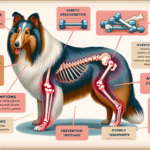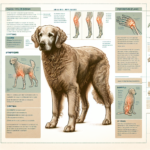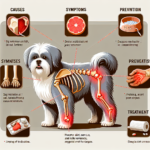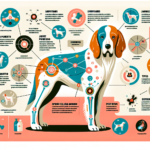Norwegian Buhund Joint Pain: Causes, Symptoms, Prevention, and Treatment
Introduction
The Norwegian Buhund is a versatile and energetic breed known for its herding capabilities and friendly demeanor. Originating from Norway, this breed has a rich history dating back to the Viking Age, where they were used for herding livestock and guarding farms. Characterized by their medium size, erect ears, and curled tail, Norwegian Buhunds are intelligent, agile, and highly trainable, making them excellent companions for active families.
Like many breeds, Norwegian Buhunds are prone to certain health issues, with joint pain being a significant concern. Joint health is crucial for maintaining the breed’s active lifestyle and overall well-being. Understanding the causes, symptoms, prevention, and treatment of joint pain in Norwegian Buhunds can help owners ensure their pets lead healthy, pain-free lives.
Breed-Specific Joint Pain Risks
Genetic Predisposition
Norwegian Buhunds, like many purebred dogs, have a genetic predisposition to certain joint-related issues. Hip dysplasia, a condition where the hip joint doesn’t fit properly into the hip socket, is a common concern. This can lead to arthritis and significant pain over time. Elbow dysplasia, another hereditary condition, affects the elbow joint and can cause lameness and discomfort. These genetic factors make it essential for breeders to screen for joint issues and for owners to be vigilant about their dog’s joint health.
Age-Related Risks
As Norwegian Buhunds age, the risk of developing joint pain increases. Arthritis, a degenerative joint disease, is particularly common in older dogs. The breed’s active nature can exacerbate wear and tear on the joints, leading to pain and stiffness. Owners should be aware of age milestones, such as middle age (around 5-7 years), when joint issues may start to become more apparent.
Activity Level and Joint Stress
Norwegian Buhunds are known for their high energy levels and need for regular exercise. While this activity is beneficial for their overall health, it can also put stress on their joints. Activities such as running, jumping, and herding can contribute to joint wear and tear. It’s important for owners to balance their dog’s activity level with joint health considerations, ensuring they get enough exercise without overexerting their joints.
Common Symptoms of Joint Pain in Norwegian Buhunds
General Symptoms
- Limping: One of the most noticeable signs of joint pain is limping or favoring one leg over another.
- Stiffness: Dogs with joint pain may show stiffness, especially after resting or during cold weather.
- Reluctance to Move: A dog experiencing joint pain may be hesitant to jump, run, or climb stairs.
- Decreased Activity: A reduction in overall activity levels can indicate discomfort in the joints.
- Swelling: In some cases, the affected joint may appear swollen or warm to the touch.
Breed-Specific Symptoms
While the general symptoms of joint pain apply to all dogs, Norwegian Buhunds may exhibit specific behaviors due to their active and alert nature. For instance, a normally energetic Buhund that suddenly becomes lethargic or less enthusiastic about playtime may be experiencing joint pain. Additionally, changes in their herding or guarding behavior could be a sign of discomfort.
When to Consult a Vet
If you notice any of the above symptoms in your Norwegian Buhund, it’s important to consult a veterinarian. Early intervention can prevent further deterioration and improve your dog’s quality of life. Persistent limping, noticeable pain, or significant changes in behavior should prompt a veterinary visit. Regular check-ups can also help catch joint issues before they become severe.
Preventive Measures for Joint Health
Exercise Recommendations
Maintaining an appropriate exercise routine is crucial for the joint health of Norwegian Buhunds. Low-impact activities such as walking, swimming, and controlled play are excellent options. These exercises help keep the joints flexible and muscles strong without putting excessive stress on the joints. Avoid high-impact activities like jumping or running on hard surfaces, especially for puppies and older dogs.
Dietary Suggestions
A balanced diet rich in essential nutrients can support joint health. Foods containing glucosamine and chondroitin can help maintain cartilage health. Omega-3 fatty acids, found in fish oil, have anti-inflammatory properties that can reduce joint pain. Consult your veterinarian for recommendations on high-quality dog food and supplements tailored to your Norwegian Buhund’s needs.
Weight Management
Maintaining a healthy weight is vital for reducing joint stress. Excess weight puts additional pressure on the joints, exacerbating pain and increasing the risk of arthritis. Monitor your dog’s weight and adjust their diet and exercise routine as needed. Regular weigh-ins and body condition assessments can help keep your Norwegian Buhund at an optimal weight.
Early Screening and Monitoring
Early screening for joint issues can help catch problems before they become severe. Regular veterinary check-ups should include joint assessments, especially as your dog ages. Breeders should also screen for genetic conditions like hip and elbow dysplasia. Early detection allows for timely intervention and better management of joint health.
Treatment Options for Joint Pain
Non-Surgical Treatments
Non-surgical treatments are often the first line of defense against joint pain. These can include:
- Medications: Anti-inflammatory drugs and pain relievers can help manage pain and reduce inflammation.
- Physical Therapy: Exercises and therapies designed to improve joint function and reduce pain.
- Lifestyle Adjustments: Modifying your dog’s activity level and environment to reduce joint stress.
Surgical Options
In severe cases, surgical intervention may be necessary. Common surgeries for joint pain include:
- Hip Replacement: Replacing a damaged hip joint with an artificial one.
- Arthroscopy: A minimally invasive procedure to clean out the joint and remove damaged tissue.
- Joint Fusion: Fusing the bones in a joint to reduce pain and improve stability.
Consult your veterinarian to determine the best surgical option for your dog’s specific condition.
Alternative Therapies
Alternative therapies can complement traditional treatments and provide additional relief. These may include:
- Acupuncture: Using needles to stimulate specific points on the body to relieve pain.
- Hydrotherapy: Water-based exercises that reduce joint stress while improving strength and flexibility.
- Massage: Therapeutic massage can help reduce muscle tension and improve circulation.
Discuss these options with your veterinarian to see if they are suitable for your Norwegian Buhund.
Lifestyle and Management Tips
Daily Care Routine
A consistent daily care routine can help manage joint pain in Norwegian Buhunds. This might include:
- Regular Exercise: Engage in low-impact activities like walking or swimming.
- Balanced Diet: Provide a diet rich in joint-supporting nutrients.
- Weight Monitoring: Keep track of your dog’s weight and adjust their diet as needed.
- Joint Supplements: Consider adding glucosamine or omega-3 supplements to their diet.
Modifying the Home Environment
Making your home more comfortable for a dog with joint pain can significantly improve their quality of life. Consider the following modifications:
- Ramps: Use ramps instead of stairs to reduce joint stress.
- Orthopedic Beds: Provide a supportive bed to alleviate pressure on the joints.
- Non-Slip Flooring: Ensure your floors are non-slip to prevent falls and injuries.
Long-Term Management
Long-term management of joint pain involves ongoing care and monitoring. Regular veterinary check-ups, consistent exercise, and a balanced diet are essential. Adjust your dog’s routine as needed to accommodate their changing needs and ensure they remain active and happy despite joint pain.
FAQs About Norwegian Buhunds and Joint Pain
What are the early signs of joint pain in Norwegian Buhunds?
Early signs include limping, stiffness, reluctance to move, and decreased activity levels. If you notice these symptoms, consult your veterinarian for an evaluation.
Can joint pain in Norwegian Buhunds be prevented?
While genetic predispositions can’t be entirely prevented, maintaining a healthy weight, providing a balanced diet, and ensuring regular, low-impact exercise can help reduce the risk of joint pain.
Are there specific foods that can help with joint health?
Yes, foods rich in glucosamine, chondroitin, and omega-3 fatty acids can support joint health. Consult your veterinarian for dietary recommendations tailored to your dog’s needs.
When should I consider surgery for my dog’s joint pain?
Surgery is usually considered when non-surgical treatments are no longer effective, and the dog’s quality of life is significantly impacted. Your veterinarian can help determine the best course of action.
Are alternative therapies effective for joint pain?
Alternative therapies like acupuncture, hydrotherapy, and massage can be effective in managing joint pain and improving overall well-being. Discuss these options with your veterinarian to see if they are suitable for your dog.
Conclusion
Joint pain is a significant concern for Norwegian Buhunds, but with proper care and attention, it can be managed effectively. Understanding the causes, symptoms, prevention, and treatment options is crucial for maintaining your dog’s joint health. Regular veterinary check-ups, a balanced diet, appropriate exercise, and weight management are key components of a comprehensive joint health strategy. By taking proactive measures and consulting with your veterinarian, you can help ensure your Norwegian Buhund leads a happy, active, and pain-free life.




